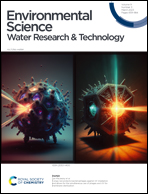Disinfection of bromide-containing tryptophan water by UV/chlorine: brominated halonitromethane formation, impact factors, and pathways†
Abstract
Brominated halonitromethanes (Br-HNMs) are frequently detected when water containing bromide (Br−) is disinfected by UV/chlorine, which are characterized by a higher toxicity to human health than common disinfection byproducts (DBPs) under strict regulation. In this study, tryptophan served as a model precursor to explore Br-HNM generation during UV/chlorine disinfection of bromide-containing water. The results indicated that the Br-HNMs formed were firstly promoted to peak values and then were reduced gradually with time. During the process, dibromonitromethane (DBNM) and tribromonitromethane (TBNM) were the predominant Br-HNM species at first, and the predominant species would be converted to bromonitromethane (BNM) with time. Furthermore, increasing the Br− concentration in the range of 0.36 to 1.80 mM or the free chlorine concentration in the range of 0.2 to 1.8 mM could significantly promote the production of Br-HNMs while increasing the pH in the range of 6.0 to 8.0 could significantly reduce the production of Br-HNMs. Subsequently, it was elaborated that the forms and concentrations of chlorine and nitrogen also changed with time in the disinfection process. Finally, the pathways of Br-HNM production from tryptophan in bromide-containing water disinfected by UV/chlorine were speculated. This study can provide a better understanding of Br-HNM generation during UV/chlorine disinfection of bromide-containing water.



 Please wait while we load your content...
Please wait while we load your content...